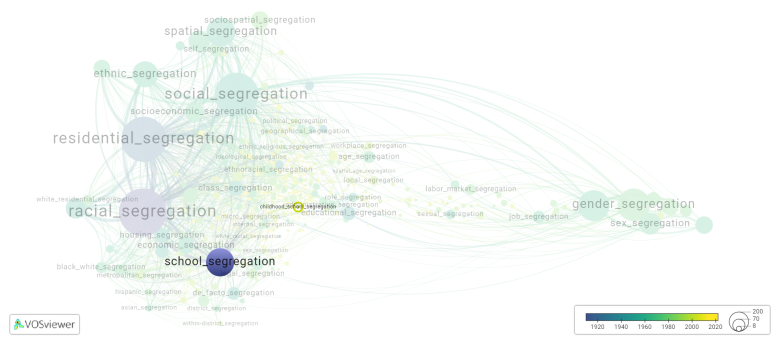Childhood school segregation: Difference between revisions
(Creating page) |
(Creating page) |
||
| (4 intermediate revisions by the same user not shown) | |||
| Line 9: | Line 9: | ||
The Supreme Court's landmark decision in Brown v. Board of Education in 1954 declared that segregation in schools was unconstitutional, leading to the desegregation of public schools across the country. However, the legacy of childhood school segregation still persists in many communities, as disparities in education and resources continue to impact minority students today. | The Supreme Court's landmark decision in Brown v. Board of Education in 1954 declared that segregation in schools was unconstitutional, leading to the desegregation of public schools across the country. However, the legacy of childhood school segregation still persists in many communities, as disparities in education and resources continue to impact minority students today. | ||
==== | ==See also== | ||
==Related segregation forms== | |||
Childhood school segregation is frequently discussed in the literature with the following segregation forms: | |||
[[school segregation]] | |||
[[File:childhood_school_segregation.png|780x780px]] | |||
This visualization is based on the study [[Segregation_Wiki:About| The Multidisciplinary Landscape of Segregation Research]]. | |||
For the complete network of interrelated segregation forms, please refer to: | |||
* [https://tinyurl.com/2235lkhw First year of publication] | |||
* [https://tinyurl.com/2d8wg5n3 Louvain clusters] | |||
* [https://tinyurl.com/223udk5r Betweenness centrality] | |||
* [https://tinyurl.com/244d8unz Disciplines in which segregation forms first emerged (Scopus database).] | |||
==References== | ==References== | ||
==Notes== | ==Notes== | ||
<references /> | <references /> | ||
{{NoteAI}} | {{NoteAI}} | ||
==Childhood | ==Childhood school segregation appears in the following literature== | ||
Wolinsky F.D., Malmstrom T.K., Miller J.P., Andresen E.M., Schootman M., Miller D.K. (2013 | Wolinsky F.D., Malmstrom T.K., Miller J.P., Andresen E.M., Schootman M., Miller D.K. (2013). Association between childhood school segregation and changes in adult sense of control in the african american health cohort. ''Journals of Gerontology - Series B Psychological Sciences and Social Sciences'', ''68''(6), 956-962. Gerontological Society of America.https://doi.org/10.1093/geronb/gbt089 | ||
Latest revision as of 07:17, 16 October 2024
Date and country of first publication[1][edit | edit source]
2013
United States
Definition[edit | edit source]
Childhood school segregation refers to the practice of segregating students based on their race or ethnicity in schools during the early years of a child's education. This practice was common in many parts of the United States prior to the civil rights movement of the 1950s and 1960s, when schools were legally allowed to separate white and non-white students into different schools or classrooms.
Segregation in schools had a devastating impact on minority students, who often received inferior education, resources, and opportunities compared to their white peers. Many minority students were forced to attend overcrowded, underfunded schools with outdated facilities and inadequate resources, while white students attended well-funded, high-quality schools.
The Supreme Court's landmark decision in Brown v. Board of Education in 1954 declared that segregation in schools was unconstitutional, leading to the desegregation of public schools across the country. However, the legacy of childhood school segregation still persists in many communities, as disparities in education and resources continue to impact minority students today.
See also[edit | edit source]
Related segregation forms[edit | edit source]
Childhood school segregation is frequently discussed in the literature with the following segregation forms:
This visualization is based on the study The Multidisciplinary Landscape of Segregation Research.
For the complete network of interrelated segregation forms, please refer to:
References[edit | edit source]
Notes[edit | edit source]
- ↑ Date and country of first publication as informed by the Scopus database (December 2023).
At its current state, this definition has been generated by a Large Language Model (LLM) so far without review by an independent researcher or a member of the curating team of segregation experts that keep the Segregation Wiki online. While we strive for accuracy, we cannot guarantee its reliability, completeness and timeliness. Please use this content with caution and verify information as needed. Also, feel free to improve on the definition as you see fit, including the use of references and other informational resources. We value your input in enhancing the quality and accuracy of the definitions of segregation forms collectively offered in the Segregation Wiki ©.
Childhood school segregation appears in the following literature[edit | edit source]
Wolinsky F.D., Malmstrom T.K., Miller J.P., Andresen E.M., Schootman M., Miller D.K. (2013). Association between childhood school segregation and changes in adult sense of control in the african american health cohort. Journals of Gerontology - Series B Psychological Sciences and Social Sciences, 68(6), 956-962. Gerontological Society of America.https://doi.org/10.1093/geronb/gbt089

